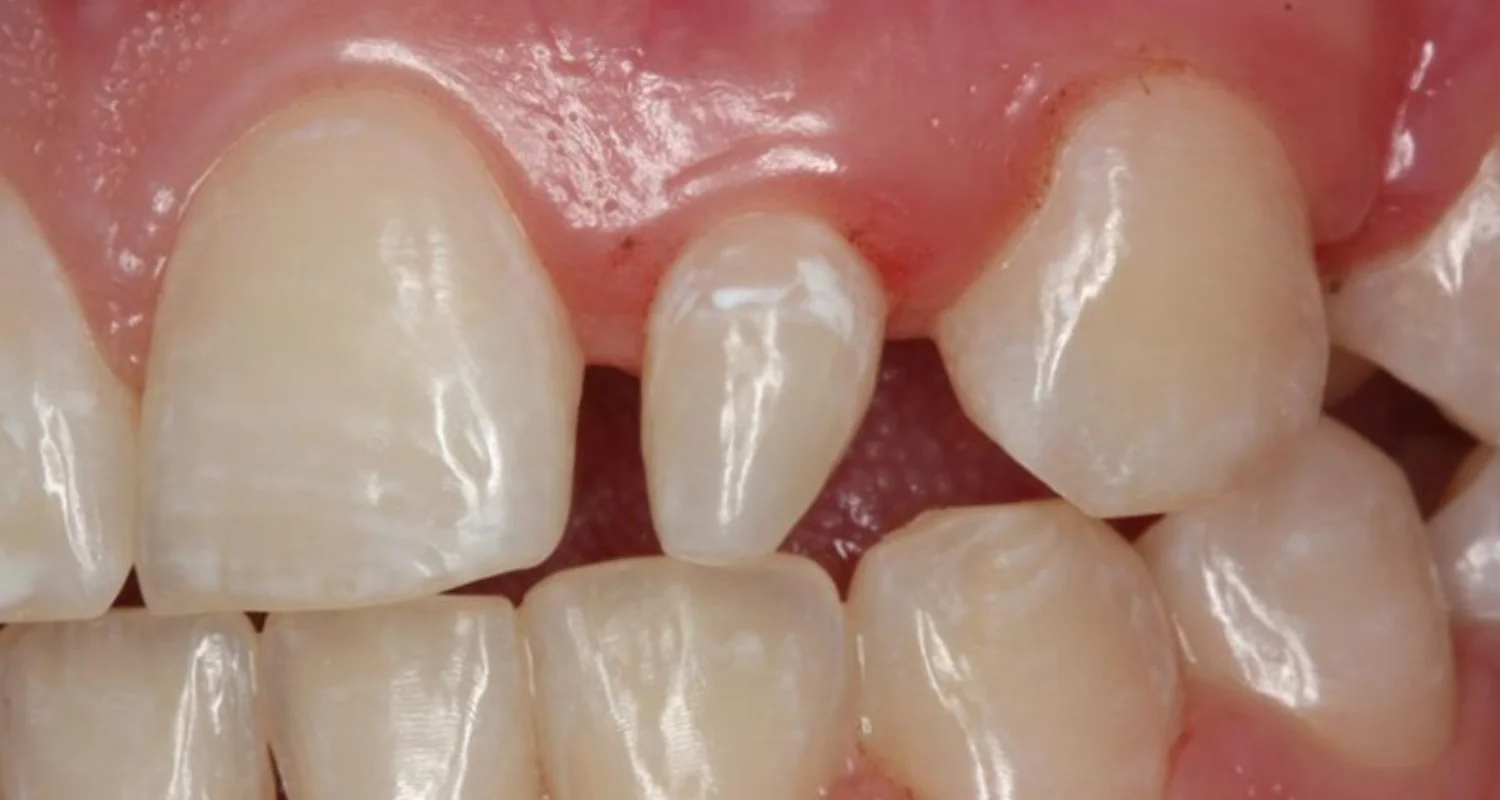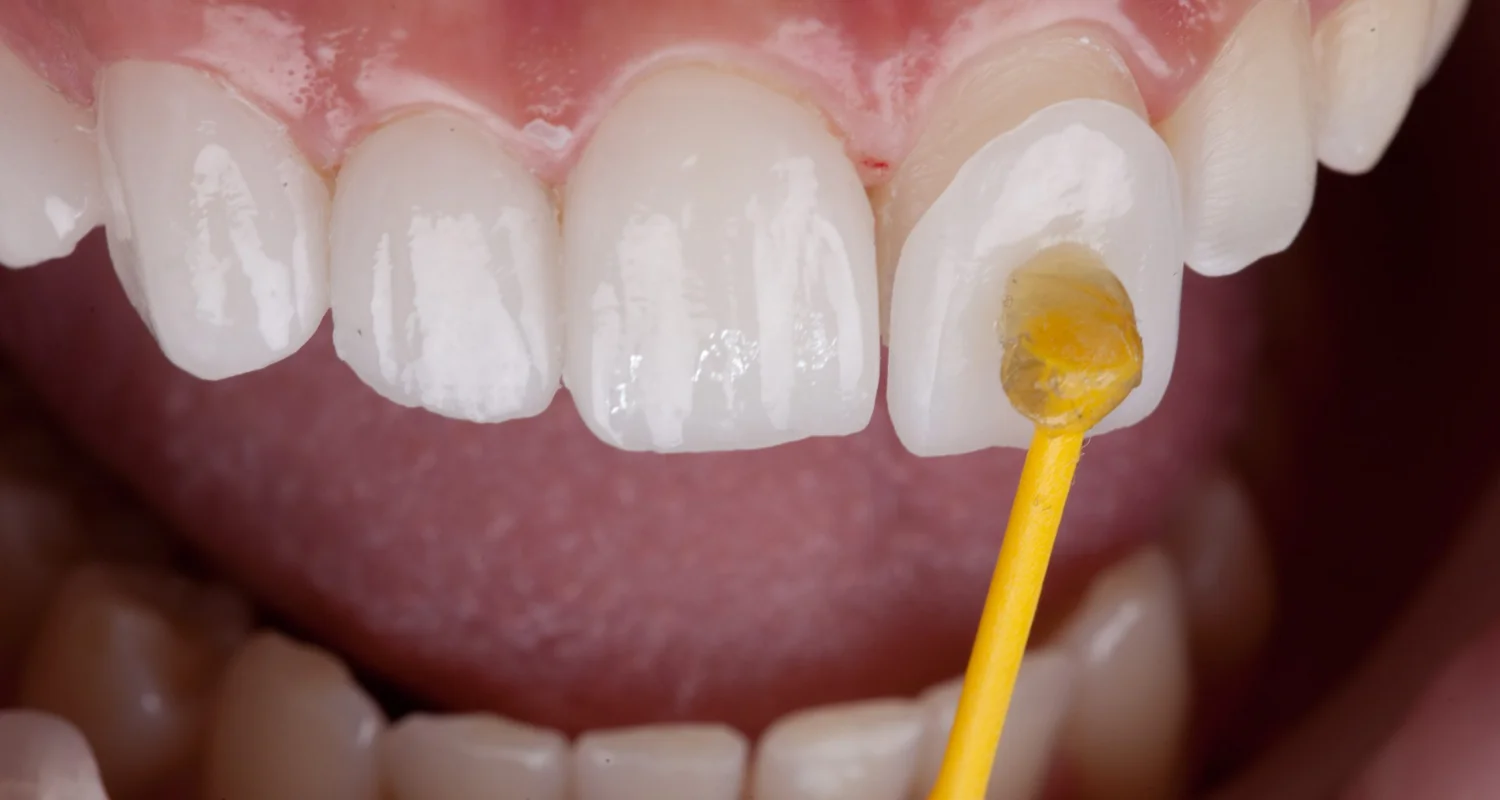Last Updated on: 16th December 2025, 11:08 am
Imagine a perfectly-aligned smile, where all the teeth have similar shapes and sizes – like puzzle pieces fitting seamlessly together. Now picture one piece that stands out, smaller and more pointed, disrupting the harmony. This is what happens with peg teeth, a dental condition which, while uncommon, can significantly affect the aesthetics and functionality of a smile.
This phenomenon affects approximately 2-5% of the population and is characterized by variations in the size and shape of certain teeth, most commonly the upper lateral incisors. But what exactly are peg-shaped teeth, and how do they impact oral health and aesthetics? Let’s dive deeper to explore their causes, consequences, and potential solutions.
What are peg teeth?
Peg teeth, also known as conical teeth, are a dental anomaly characterized by smaller-than-average teeth with a tapered or pointed shape. This condition most commonly affects the upper lateral incisors, which are the teeth located on either side of the two central front teeth. Their distinctive appearance disrupts the natural symmetry of a smile, making them a noticeable aesthetic concern for many individuals.
Peg teeth result from an interruption or irregularity during the dental development process, such as microdontia (abnormally small teeth) or tooth agenesis (incomplete tooth formation, often involving short roots). While this condition is not medically serious, it can impact both the appearance and functionality of the teeth. In some cases, peg teeth may affect the bite or make it harder to achieve proper oral hygiene.
The condition can appear in both primary (baby teeth) and permanent teeth and sometimes involves multiple teeth in the mouth. Individuals with peg teeth often seek cosmetic dentistry solutions, such as veneers, crowns, or composite bonding, to restore their smile’s harmony and improve oral functionality.
Causes of peg teeth
Peg teeth can arise from a variety of reasons, and identifying these causes helps to better understand this dental condition. The main causes are:
1. Genetics: The most frequent cause of peg teeth is hereditary. If someone in your family has had cone-shaped teeth, there’s a chance that this trait might be passed down to you. Similar to inheriting physical features like eye color or the shape of your nose, the way teeth form is largely influenced by your genetic makeup.
2. Dental developmental anomalies: During tooth formation, disruptions can occur that alter their size and shape. These disruptions may involve problems with the cells responsible for tooth development or with the creation of tissues like enamel (the hard outer layer) and dentin (the layer beneath the enamel). These issues can lead to teeth that are smaller and have a pointed, tapered appearance.
3. Congenital conditions: Certain medical conditions present from birth, such as ectodermal dysplasia, are linked to peg teeth. These conditions not only affect tooth development but also impact other structures like hair, nails, and skin, leading to unusual tooth shapes as part of broader systemic changes.
4. Environmental factors: External factors can also influence tooth formation. For instance:
● High levels of fluoride or certain medications, like tetracycline, during early childhood can interfere with normal tooth growth.
● Trauma or infections while teeth are forming can disrupt their shape.
● Poor nutrition, particularly deficiencies in essential vitamins and minerals, may impair proper tooth development.
Understanding these causes is essential for addressing peg teeth effectively. It’s important not only to know where the condition comes from but also to be aware of how it might affect oral health, function, and appearance. This awareness can help guide individuals toward the best solutions for their needs.
Consequences of Untreated Peg Teeth
While peg teeth may not always pose an immediate medical concern, leaving them untreated can lead to several significant consequences over time:
● Spacing issues:
Peg teeth are smaller than normal, so they often leave extra space around them. These gaps, called diastemas, can make it easier for food to get stuck, leading to cavities and gum problems. Plus, if nothing is done, the gaps can get even bigger over time, making the teeth look even more uneven.
● Bite misalignment:
When peg teeth throw off the balance of your smile, it can mess with how your teeth come together when you bite. This might cause extra pressure on your jaw and uneven wear on your teeth. Over time, this can lead to discomfort, especially when chewing, or even jaw pain.
● Oral hygiene challenges:
The unusual shape and size of peg teeth can create tricky spots to clean when brushing or flossing. Think of it like trying to clean crumbs out of a small corner, it’s easy to miss something! These hard-to-reach spots can lead to plaque buildup, which can cause cavities and gum disease.
● Aesthetic concerns:
Let’s face it, peg teeth can make your smile look a little uneven. For many people, this affects their confidence, making them feel shy about smiling, talking, or even laughing in public.
Even though peg teeth might not seem like a big medical issue, they can cause both practical and emotional challenges. Fixing them isn’t just about looks; it’s also about keeping your teeth healthy and feeling good about your smile!
Treatment Options for Peg Teeth
There are several ways to improve the look and function of peg teeth, depending on how severe the issue is and what works best for you. Let’s break down the most common treatments:
1. Dental veneers
Think of veneers like a “beauty shield” for your teeth! These are thin layers made of porcelain or resin that are carefully placed on the front of your tooth. Veneers can change the shape of peg teeth, making them look smooth, balanced, and perfectly in line with your other teeth. If you’re after a natural and long-lasting fix, veneers are a fantastic option!
2. Dental crowns
Crowns are like a little hat for your tooth! They completely cover a small or fragile peg tooth, making it stronger and giving it a normal, uniform shape. While the dentist may need to shape the tooth slightly to fit the crown, it’s a super durable solution that looks just like a regular tooth.
3. Orthodontics
Orthodontics is all about straightening your smile. If peg teeth are causing alignment or bite issues, braces or aligners can help shift your teeth into the right position. In some cases, orthodontics can even make room for a peg tooth to be reshaped or restored to its proper size. It’s like giving your teeth a fresh start!
4. Extraction and replacement
Sometimes, if a peg tooth is causing a lot of problems or is too small to fix, removing it might be the best choice. But don’t worry, you won’t be left with a gap! Dentists can replace the missing tooth with an implant or a bridge to give you a full, functional smile again.
Every treatment is designed to suit your unique situation, and your dentist is there to help you decide what’s best for your smile. Whether it’s a small change or a complete transformation, there’s a solution to help you feel confident and happy about your teeth!
Prevention of Peg Teeth
While you can’t always avoid peg teeth, there are some things you can do to reduce the chances or make sure any issues are caught early. Let’s look at how you can help:
● Prenatal care: A healthy pregnancy helps set the stage for your baby’s teeth to develop properly. Eating nutritious foods, like those rich in folic acid, and visiting your doctor regularly can give your baby the best start. Think of it as laying a strong foundation for their little teeth!
● Genetic counseling: If peg teeth run in your family, genetic counseling can give you useful insights. It’s like getting a heads-up about potential risks so you can plan early interventions if needed. This way, you can be prepared and take action before the condition even becomes an issue.
● Regular dental check-ups for children: Start taking your child to the dentist early! Regular check-ups help spot any unusual growth or development of teeth. Dentists will keep an eye on how things are shaping up and offer advice or treatments to prevent problems down the road.
● Proper oral hygiene routine: Maintaining good oral hygiene from childhood helps prevent problems that could worsen the effects of peg teeth. This includes brushing teeth at least twice a day, using dental floss, and rinsing with mouthwash to keep gums and teeth healthy.
● Healthy diet: What you eat matters for healthy teeth! Foods packed with calcium, vitamins, and other nutrients help teeth grow strong and properly shaped. Plus, cutting back on sugary and acidic snacks will protect teeth from decay. It’s all about giving teeth the fuel they need to grow their best.
Taking these simple steps won’t guarantee peg teeth won’t happen, but they can definitely help keep your child’s teeth as healthy as possible. Early care and attention make all the difference!
Conclusion
Peg teeth, while often seen as primarily a cosmetic issue, can also impact oral health and self-confidence. Understanding their causes, symptoms, and available treatments helps individuals make informed choices about their dental care.
Thanks to ongoing advancements in restorative and cosmetic dentistry, achieving a balanced, healthy, and confident smile is more accessible than ever. Consulting with a dental professional is an essential first step to evaluate each case personally and choose the most suitable treatment. By addressing peg teeth with the right care, patients can enhance their quality of life and enjoy the benefits of a beautiful, functional smile.
Frequently Asked Questions
Can peg teeth be whitened like other teeth?
Yes, peg teeth can be whitened, but their small size or unusual shape may limit the effectiveness. Many people choose veneers or crowns instead, which also improve the tooth’s appearance and shape.
Can peg teeth develop in baby teeth?
Yes, peg teeth can occur in baby teeth, though it’s less common. If present, it’s a good idea to monitor the development of the adult teeth and plan for treatment if needed.
Can peg teeth affect speech?
Yes, peg teeth can sometimes affect speech, though it’s not very common and tends to be mild. The irregular shape or size of peg teeth, as well as any gaps they create, can interfere with how the tongue and teeth interact during speech. This might make it harder to articulate certain sounds, especially those that require precise tongue placement, like “s,” “z,” or “th.”
Do peg teeth cause pain?
Peg teeth themselves don’t usually cause pain. However, complications like cavities, gum problems, or bite issues associated with peg teeth might lead to discomfort.
Can peg teeth grow back after extraction?
No, once a peg tooth is extracted, it does not grow back. It can be replaced with a dental implant or bridge to restore the function and appearance of the tooth.
Share
References
1. Ariyakriangkai, W., Vargas, M. & Kwon, S. (2017, 1 october). Management of Peg-Shaped Maxillary Lateral Incisors and Congenitally Missing Mandibular Lateral Incisors. Decisions in Dentistry. https://decisionsindentistry.com/article/management-peg-shaped-maxillary-lateral-incisors-congenitally-missing-mandibular-lateral-incisors/
2. Dolan, S., Calvert, G., Crane, L., Savarrio, L., & Ashley, M. P. (2023, 13 october). Restorative dentistry clinical decision-making for hypodontia: peg and missing lateral incisor teeth. BDJ, 235(7), 471-476. https://doi.org/10.1038/s41415-023-6330-7
3. Larson, J. (2020, 26 february). What causes small teeth? Healthline. https://www.healthline.com/health/small-teeth
4. Omeish, N., Nassif, A., Feghali, S., Vi‐Fane, B., & Bosco, J. (2022, 1 march). Esthetic and functional rehabilitation of peg‐shaped maxillary lateral incisors: Practical recommendations. Clinical Case Reports, 10(3). https://doi.org/10.1002/ccr3.5507
5. Severin, E., Moldoveanu, G. G., & Moldoveanu, A. (2021, 2 September). Failure of Tooth Development: Prevalence, Genetic Causes and Clinical Features. En IntechOpen eBooks. https://doi.org/10.5772/intechopen.99419
-
Dr. Yeidy Carolina Mesa [Author]
DDS Yeidy Carolina Mesa Passionate Dentist | Advocate for Accessible Oral Health Education Graduating from Universidad CES in 2022, I am a dedicated general dentist with a lifelong passion for helping others and making a meaningful impact in the world. My journey into dentistry began at the age of 7, inspired by my own experience with braces and overcoming a fear of the dentist. This personal journey shaped my mission to help patients conquer their own dental anxieties and embrace a healthier,...
View all posts




















